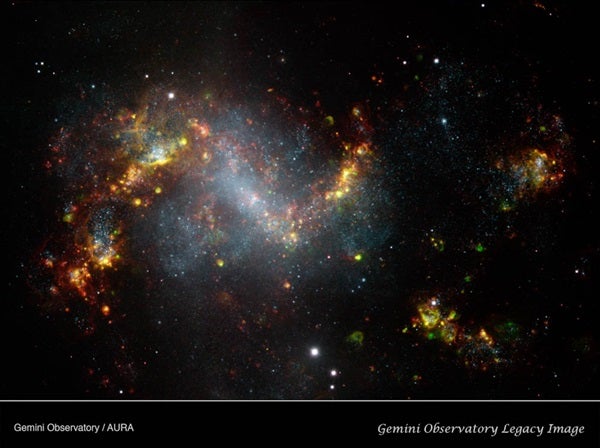The starburst galaxy NGC 1313 is a stellar incubator delivering stars on a scale rarely seen in a single galaxy of its size. Now a striking new Gemini Observatory image reveals the multitudes of glowing gas clouds in this galaxy’s arms. These colorful clouds are the telltale sign of star formation in this prolific star factory.
Because the clouds of gas in stellar nurseries emit light from ionized gas —, they shine brightly in very specific colors (or wavelengths) — narrow-band filters were used on the Gemini Multi-Object Spectrograph on the Gemini South telescope in Chile to capture the colorful galactic light-scape. The unprecedented detail and clarity of the image reveals myriad bubbles, shock fronts, star clusters, and sites where massive stars are being born.
Located some 15 million light-years away, NGC 1313 is a late-type barred spiral galaxy. It’s a relatively close galactic neighbor to the Milky Way and has a mysterious past. Generally, starburst galaxies show some signs of interaction with another galaxy, and a close galactic encounter is usually responsible for sparking increased levels of star-birth activity. However, NGC 1313 is a neighborless “drifter” far away from any other packs of galaxies. The cause of its deformed shape and high rate of star formation is not obvious.
In radio studies of the underlying gas distribution aimed at solving the mystery of this galaxy’s active star formation rate, it appears that the edge of an expanding “super-bubble” is causing gas to pile up and spur the formation of stars. “What triggered the super-bubble is still a mystery,” said Stuart Ryder, Australian Gemini scientist at the Anglo-Australian Observatory who has studied this galaxy extensively. “It would have required about a thousand supernovae to go off in the space of just a few million years, or else something punched its way through the disk and set it off like ripples in a pond.”
Astronomers also speculate that nearby gas clouds may be falling into (or orbiting) the galaxy, and this could be prompting localized starbursts. The bottom line is that this galaxy still has a lot of questions for astronomers to answer.
Despite its mysteries, even a casual glance at NGC 1313’s morphology reveals a well-defined bar with twisted, asymmetric spiral arms. While pronounced star formation appears along the outer reaches of both arms, it’s much stronger to the northeast (left on the new Gemini image). Other regions of star formation are nearby, especially to the southwest (right) where they appear disconnected due to the action of the super-bubble. Very deep exposures also show extensive turmoil in the outer regions of the galaxy. Despite the apparent visual chaos, NGC 1313 has a uniformly rotating disk inclined at 48° to our line of sight.
In addition, the galaxy hosts several sources of energetic X-rays from what are called ultraluminous X-ray sources (ULXs). It is thought that most ULXs are powered by intermediate-mass black holes formed during the demise of large binary star systems. One of them, known as NGC 1313 X-2, appears to be a massive black hole of up to several hundred solar masses. It draws matter from a 12 to 15 solar-mass main-sequence star. Another one, called NGC 1313 X-1, may harbor a black hole twice as massive. The final X-ray source is produced by shock emission from Supernova 1978K.
In the new Gemini image, three narrow-band filters isolate the various features of ionized hydrogen (red), helium (blue), and oxygen (green). These specific colors dominate star-forming regions where hot gas glows brightly and paints the complex network of clouds spanning thousands of light-years. The galaxy itself extends across about 50,000 light-years — about half the extent of the Milky Way — and is located in the direction of the far southern constellation Reticulum.










